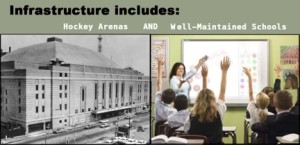Sachin Maharaj is a PhD student in educational policy at the Ontario Institute for Studies in Education, University of Toronto and is a teacher in the Toronto District School Board. She wrote the following opinion piece for the Toronto Star, which was published August 6:
Kim Campbell, Mike Harris, Kathleen Wynne, and Olivia Chow. What do all of these politicians have in common? They are members of a long and ever-growing list of former school trustees who left their school boards for other (some would say higher) political office.
And now you can add Shaun Chen, the chair of the Toronto District School Board, to that list. Chen recently resigned his post as leader of Canada’s largest school board, less than a year after assuming the position, in order to run for the Liberals in the upcoming federal election. And trustees don’t just leave for Ottawa. Both Toronto City Hall and Queen’s Park contain several former school trustees. So why is it that so many people abandon their jobs as school trustees and instead seem to use the position as a political launching pad?
One big reason is that despite being structured by the province as a quasi-volunteer position, being a good school trustee is a lot of work. According to my own recent study, the average school trustee in Ontario spends about 20 hours per week responding to parent concerns, visiting schools, attending parent councils, on top of official board and committee meetings.
In large school boards, like the TDSB, this time commitment extends to over 30 hours per week. But despite requiring the hours of between half to three-quarters of a full-time job, trustees are paid a pittance. The average trustee in Ontario gets paid $11,468, which works out to around minimum wage on an hourly basis. Is it any wonder then that so many leave?
Of course some critics might say that trustees are not expected to subsist on the meagre compensation they receive, but are instead expected to have other full-time employment. But given the time demands of the role, most trustees report that this is “almost impossible.” Indeed, only one-third of school trustees are employed full-time. As one trustee put it, “I could not do this job if I were employed professionally.” Another indicated that they had “left a part time-job due to time commitment as trustee.” And as most of a trustee’s work takes place in the evenings, this can take a toll on family life as well. One trustee sadly recounted, “My children miss me. I rarely see them in the evenings during the week.”
But another reason that many trustees leave is due to increased feelings of impotence, as provincial governments of all stripes have stripped away more and more of their autonomy.
It started when the Harris government removed the ability of school boards to levy tax increases to fund local needs. While this benefited smaller, rural school boards with less ability to raise money, it has been a disaster for the TDSB, which currently faces a repair backlog of over $3 billion. The Wynne government continued this trend of undermining school boards with the introduction of Regulation 274, which removed the ability of boards to hire the best teachers. Indeed, in a recent survey of over 2,000 principals from across Ontario, over 94 per cent stated that Regulation 274 had prevented them from hiring teachers that best meet the needs of their school and its students.
So if we want to attract the highest quality candidates as school trustees, and prevent them from jumping ship, the solution is obvious. We need to pay trustees well, treat them with respect and give them the autonomy they require to best serve the students in their communities.
Then perhaps more people will be school trustees solely because they care about the job, instead of seeing it as a stepping stone. And given that the job of school trustees is overseeing the education of our children, perhaps no political office is more important.
 Surely, public schools are key social infrastructure in this country? Childcare and early learning most often occurs in public schools so using federal infrastructure money to ensure these buildings are in good condition makes a lot of sense! And, finally, if federal dollars can go towards recreational infrastructure like hockey arenas, surely they can go towards fixing public schools?
Surely, public schools are key social infrastructure in this country? Childcare and early learning most often occurs in public schools so using federal infrastructure money to ensure these buildings are in good condition makes a lot of sense! And, finally, if federal dollars can go towards recreational infrastructure like hockey arenas, surely they can go towards fixing public schools?
